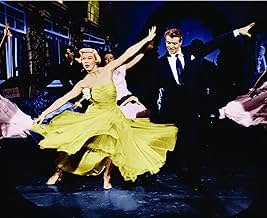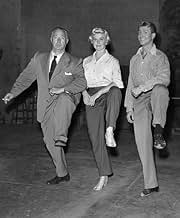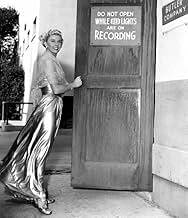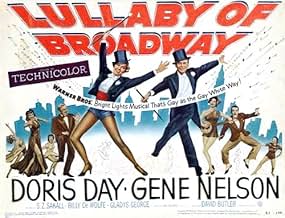IMDb रेटिंग
6.7/10
1.3 हज़ार
आपकी रेटिंग
अपनी भाषा में प्लॉट जोड़ेंA showgirl returns to her New York home to visit her alcoholic mother, where she catches the eye of a Broadway producer.A showgirl returns to her New York home to visit her alcoholic mother, where she catches the eye of a Broadway producer.A showgirl returns to her New York home to visit her alcoholic mother, where she catches the eye of a Broadway producer.
- पुरस्कार
- कुल 2 जीत
Bill Alcorn
- Dancer
- (बिना क्रेडिट के)
Murray Alper
- Joe the Bartender
- (बिना क्रेडिट के)
Jimmy Aubrey
- Ship's Steward
- (बिना क्रेडिट के)
Brooks Benedict
- Reporter
- (बिना क्रेडिट के)
Lulu Mae Bohrman
- Party Guest
- (बिना क्रेडिट के)
Tex Brodus
- Party Guest
- (बिना क्रेडिट के)
फ़ीचर्ड समीक्षाएं
After living in England, bubbly American singer-dancer Doris Day (as Melinda Howard) sails for New York. Aboard ship, Ms. Day meets likewise inclined Gene Nelson (as Tom Farnham), a Broadway star, homeward bound. The two are mutually attracted, but Day finds Mr. Nelson too forward. Day expects to return to her mother's mansion, but the house had been sold to blustery German brewer S.Z. Sakall (as Adolph Hubbell). A former Broadway star, Day's mother Gladys George (as Jessica Howard) has hit the skids, and is trying to lay off the sauce. Butler Billy De Wolfe (as Lefty Mack) tries to hide the truth from Day...
"Lullaby of Broadway" wisely brings Gene Nelson back for more singing and dancing with Doris Day. They had created momentary magic in a previous minor picture, "Tea for Two" (1950). Jumping on a piano and dancing incredibly with Day on a staircase, Nelson moves up to leading man, herein. While the co-stars are wonderful, the production has the appearance of quickly being thrown together, with familiar songs and reheated story lines. Strangely, Nelson's singing is dubbed. However, Day and Nelson are marvelous. One wonders what they would do at MGM, if afforded material like "Singing in the Rain" (1952).
****** Lullaby of Broadway (3/26/51) David Butler ~ Doris Day, Gene Nelson, Gladys George, S. Z. Sakall
"Lullaby of Broadway" wisely brings Gene Nelson back for more singing and dancing with Doris Day. They had created momentary magic in a previous minor picture, "Tea for Two" (1950). Jumping on a piano and dancing incredibly with Day on a staircase, Nelson moves up to leading man, herein. While the co-stars are wonderful, the production has the appearance of quickly being thrown together, with familiar songs and reheated story lines. Strangely, Nelson's singing is dubbed. However, Day and Nelson are marvelous. One wonders what they would do at MGM, if afforded material like "Singing in the Rain" (1952).
****** Lullaby of Broadway (3/26/51) David Butler ~ Doris Day, Gene Nelson, Gladys George, S. Z. Sakall
If you love Fifties movie-musicals that stress music over story, "Lullaby of Broadway" is the prototype. It takes moviemaking back to the Astaire-Rogers films, which highlighted dancing, music, and wisecracking dialogue. "Lullaby" isn't quite "Top Hat", but it does represent a trend where old, sentimental hit tunes are given updated arrangements and settings.
In her autobiography, "Doris Day: Her Own Story" (published in 1976), the actress describes her early years as a contract player for Jack Warner and the heated disputes she had with the autocratic movie czar over miscasting and bad scripts. But in "Lullaby," there is virtually no script to complain about. It's mainly a revue. But what a revue! From Ray Heindorf's jazzy rendition of the old title tune (from "Gold Diggers of 1935") over the opening credits to the end, this movie clicks along in high gear from one showstopper to the next.
Day also recalled in her memoirs that "Lullaby" contained, by far, the toughest dance routines of any film she ever made. One especially challenging scene called for her to perform an intricate series of steps on a huge staircase while weighed down in a gold-lame dress. At first, she balked, warning the crew to have an ambulance waiting after the first take. With encouragement from the director David Butler and others, however, she managed to complete the number.
"Lullaby of Broadway" is not the best of the Day/Warners musicals--that distinction goes to "Calamity Jane" (1953)--but it's as good as the rest. With Gene Nelson as Day's love interest, Billy De Wolfe as a vaudevillian-turned-valet, and S. Z. Sakall as a Broadway "angel."
In her autobiography, "Doris Day: Her Own Story" (published in 1976), the actress describes her early years as a contract player for Jack Warner and the heated disputes she had with the autocratic movie czar over miscasting and bad scripts. But in "Lullaby," there is virtually no script to complain about. It's mainly a revue. But what a revue! From Ray Heindorf's jazzy rendition of the old title tune (from "Gold Diggers of 1935") over the opening credits to the end, this movie clicks along in high gear from one showstopper to the next.
Day also recalled in her memoirs that "Lullaby" contained, by far, the toughest dance routines of any film she ever made. One especially challenging scene called for her to perform an intricate series of steps on a huge staircase while weighed down in a gold-lame dress. At first, she balked, warning the crew to have an ambulance waiting after the first take. With encouragement from the director David Butler and others, however, she managed to complete the number.
"Lullaby of Broadway" is not the best of the Day/Warners musicals--that distinction goes to "Calamity Jane" (1953)--but it's as good as the rest. With Gene Nelson as Day's love interest, Billy De Wolfe as a vaudevillian-turned-valet, and S. Z. Sakall as a Broadway "angel."
Another of my most enjoyable movie musicals with my favorite star, Doris Day, singing and dancing with Gene Nelson. I'll never forget the tap dance they did together going up a staircase-fantastic! An excellent cast includes Gladys George, and two of the funniest men around in the 50s: cute S.Z. Sakall and that buggy-eyed looney Billy DeWolfe who will tickle your funnybone. Sakall played in most of Doris' musicals and he is a character to remember! Whatever happened to Gene Nelson? He was surely a fine dancer!
In a different perspective of the plot for Lady For A Day, Warner Brothers gave Doris Day one of her best musical films in Lullaby Of Broadway. They even tributed Busby Berkeley somewhat in the finale number.
The story involves Doris as a young performer who has spent her childhood in the United Kingdom with money sent to her by her mother who she believes is a famous Broadway star. That's in the past tense unfortunately mom who is played by Gladys George now sings in a cheap cabaret in the seamier parts of Greenwich Village.
But Doris is such a good kid that everyone tries to keep the illusion going from former vaudeville colleagues Billy DeWolfe and Anne Triola to S.Z. Sakall whom they now work for as butler and maid. She even gets involved with rising new Broadway performer Gene Nelson. But she also innocently almost breaks up S.Z. Sakall's marriage to Florence Bates. Now there's a couple to contemplate about.
In her memoirs Doris Day said that S.Z. Sakall in real life was the same lovable uncle type that he played so well in films. And yes no one could resist pinching those cheeks either.
Gene Nelson sad to say came along just a half generation too late to become a major film star. He had the moves and he had the talent, possibly he was not a creative individual in the way that Fred Astaire or Gene Kelly was. I think he was in their league as a performer and he'd be as known as they are today if he had that creative talent that they did which is why they've become the legends they are. Maybe Nelson never got the chance they did. Anyway this was his only lead in a major motion picture and it didn't make him a star because musicals were on the downside.
Gladys George has only a few scenes, but she really makes them count when she's on screen. One of her more memorable characters in earlier years was the Texas Guinan like performer in The Roaring Twenties who carries a torch for James Cagney. When that film ends she's singing in a dive and her character could be an extension of Panama whom she played in The Roaring Twenties.
As often as not for Doris Day films Warner Brothers reached into their trunk catalog and in this case got the title song and another standard written by Harry Warren and Al Dubin, You're Getting To Be A Habit With Me. Here though they outdid themselves for Doris and Gene using stuff like Somebody Loves Me and Just One Of Those Things. When you've got George Gershwin and Cole Porter contributing to the score the rest doesn't even matter.
Watching the finale number which is the title song, sung by Doris and danced by Gene Nelson and a chorus it plays very similar to the choreographic sequences in Golddiggers of 1935 where Lullaby Of Broadway was introduced. No kaleidoscopic overhead shots that characterized those old Warner Brothers musicals from the Thirties are here, but in all other respects they seem to have copied Mr. Berkeley well.
Lullaby Of Broadway has a nice backstage plot, it's a throwback to their musicals of the Depression in many respects and it provides Doris Day with many opportunities to display singing and dancing talents. And it holds up well today.
The story involves Doris as a young performer who has spent her childhood in the United Kingdom with money sent to her by her mother who she believes is a famous Broadway star. That's in the past tense unfortunately mom who is played by Gladys George now sings in a cheap cabaret in the seamier parts of Greenwich Village.
But Doris is such a good kid that everyone tries to keep the illusion going from former vaudeville colleagues Billy DeWolfe and Anne Triola to S.Z. Sakall whom they now work for as butler and maid. She even gets involved with rising new Broadway performer Gene Nelson. But she also innocently almost breaks up S.Z. Sakall's marriage to Florence Bates. Now there's a couple to contemplate about.
In her memoirs Doris Day said that S.Z. Sakall in real life was the same lovable uncle type that he played so well in films. And yes no one could resist pinching those cheeks either.
Gene Nelson sad to say came along just a half generation too late to become a major film star. He had the moves and he had the talent, possibly he was not a creative individual in the way that Fred Astaire or Gene Kelly was. I think he was in their league as a performer and he'd be as known as they are today if he had that creative talent that they did which is why they've become the legends they are. Maybe Nelson never got the chance they did. Anyway this was his only lead in a major motion picture and it didn't make him a star because musicals were on the downside.
Gladys George has only a few scenes, but she really makes them count when she's on screen. One of her more memorable characters in earlier years was the Texas Guinan like performer in The Roaring Twenties who carries a torch for James Cagney. When that film ends she's singing in a dive and her character could be an extension of Panama whom she played in The Roaring Twenties.
As often as not for Doris Day films Warner Brothers reached into their trunk catalog and in this case got the title song and another standard written by Harry Warren and Al Dubin, You're Getting To Be A Habit With Me. Here though they outdid themselves for Doris and Gene using stuff like Somebody Loves Me and Just One Of Those Things. When you've got George Gershwin and Cole Porter contributing to the score the rest doesn't even matter.
Watching the finale number which is the title song, sung by Doris and danced by Gene Nelson and a chorus it plays very similar to the choreographic sequences in Golddiggers of 1935 where Lullaby Of Broadway was introduced. No kaleidoscopic overhead shots that characterized those old Warner Brothers musicals from the Thirties are here, but in all other respects they seem to have copied Mr. Berkeley well.
Lullaby Of Broadway has a nice backstage plot, it's a throwback to their musicals of the Depression in many respects and it provides Doris Day with many opportunities to display singing and dancing talents. And it holds up well today.
Light entertainment at its best, a great guilty pleasure for your pc.
This film boasts surprisingly strong performances by a solid cast: let's say it, a cast humble enough to throw themselves into an odd sort of film: part melodrama, part musical, part fashion show for its star.
Radiating joie-de-vivre, out-singing anyone of her time, serious one moment then tongue-in-cheek the next, Day is a star, an under-rated one these days.
Gene Nelson's dancing is important to see if only to better understand Fred Astaire's. The Astaire difference was this: talent, yes, Nelson had it as well, but not the ability to bring us to the brink of something endless through his motions: to make you know he was on the edge of something vast and mysterious; to suggest a whole unseen world by dancing in this one. Bravo, Fred!
This film boasts surprisingly strong performances by a solid cast: let's say it, a cast humble enough to throw themselves into an odd sort of film: part melodrama, part musical, part fashion show for its star.
Radiating joie-de-vivre, out-singing anyone of her time, serious one moment then tongue-in-cheek the next, Day is a star, an under-rated one these days.
Gene Nelson's dancing is important to see if only to better understand Fred Astaire's. The Astaire difference was this: talent, yes, Nelson had it as well, but not the ability to bring us to the brink of something endless through his motions: to make you know he was on the edge of something vast and mysterious; to suggest a whole unseen world by dancing in this one. Bravo, Fred!
क्या आपको पता है
- ट्रिवियाWhen Doris Day's character is questioned by reporters about an affair she's supposedly having with S.Z. Sakall's character, one of them asks her, "Is it true you call him 'Cuddles'?" This is an inside joke, as Sakall's nickname in real life was "Cuddles".
- गूफ़Gloria reads a copy of Variety with news on the back cover; in reality, the back cover of this publication has always been reserved for full-page ads.
- भाव
Melinda Howard: [handing Tom a penny] There's a message on that to you from the women of the world.
Tom Farnham: In God We Trust
- कनेक्शनFeatured in The 69th Annual Academy Awards (1997)
- साउंडट्रैकLullaby of Broadway
(uncredited)
Music by Harry Warren
Lyrics by Al Dubin
Sung by Doris Day
Danced by DDoris Day and Gene Nelson and mixed chorus
टॉप पसंद
रेटिंग देने के लिए साइन-इन करें और वैयक्तिकृत सुझावों के लिए वॉचलिस्ट करें
- How long is Lullaby of Broadway?Alexa द्वारा संचालित
विवरण
- रिलीज़ की तारीख़
- कंट्री ऑफ़ ओरिजिन
- भाषा
- इस रूप में भी जाना जाता है
- Das Wiegenlied vom Broadway
- फ़िल्माने की जगहें
- उत्पादन कंपनी
- IMDbPro पर और कंपनी क्रेडिट देखें
- चलने की अवधि
- 1 घं 32 मि(92 min)
- पक्ष अनुपात
- 1.37 : 1
इस पेज में योगदान दें
किसी बदलाव का सुझाव दें या अनुपलब्ध कॉन्टेंट जोड़ें


































